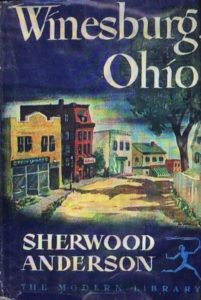Sherwood Anderson
(1876–1941), author of Winesburg, Ohio, the classic 1919 short story
cycle based on his early life in Clyde, Ohio, that influenced Fitzgerald and Hemingway, for whom he was also an important mentor, opening doors and lending encouragement to the aspiring younger writer. Structured around the life of fictional protagonist George Willard, from childhood to his growing independence and ultimate abandonment of Winesburg as a young man, this innovative book was well received by critics despite some reservations about its moral tone and unconventional storytelling. It is now considered one of the most influential portraits of pre-industrial small-town life in the United States.
Anderson was one of the first American novelists to introduce new insights from psychology, including Freud. “The term ‘existentialism’ didn’t exist back when Sherwood Anderson wrote his master- work,” says Twenties scholar Ted Gioia. “Heidegger’s Being and Time was still more than a decade in the future, and Kierkegaard had not yet been translated into English. But Anderson’s characters, in story after story, face a challenge of meaning, of self-definition. Their hidden secret is not some private vice, but something much larger: they are struggling to discover what sort of person they really are. … The casual observer of the citizens of Winesburg, Ohio, sees nothing but the familiar comings-and-goings of civic life. Only the reader is brought into the inner sanctum, and given an elusive glimpse of the secrets within. This is a big time achievement for a book on small town America. And—despite the countless send-offs of suburban and village dysfunction that have followed in Sherwood Anderson’s wake—one that no one has yet surpassed.”

Sherwood Anderson, 1933. (Carl Van Vechten/Van Vechten Collection at Library of Congress; licensed under public domain via Wikimedia Commons)
Anderson had been a successful copywriter and business owner in Elyria and Cleveland until a 1912 nervous breakdown led him to abandon his business and family to become a writer. He published several other short story collections, novels, memoirs, books of essays, and a book of poetry. Fitzgerald considered Anderson’s 1923 novel Many Marriages, which explored the new sexual freedom, to be his finest work. Dark Laughter (1925), a novel inspired by Anderson’s time in New Orleans in the 1920s, was a bestseller. Poor White was recently reissued in a new edition by Belt Revivals here. CSU English Dept. chair Frederick J. (Jeff) Karem is an authority on regional literature.